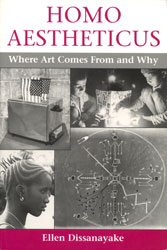Books
Homo Aestheticus: Where Art Comes From and Why
1992 New York: Free Press.

(Reprinted in paperback, University of Washington Press, December 1995; second paperback printing 1996; third paperback printing 1999; fourth paperback printing 2004). Selection of Readers Subscription and Natural Science Book Clubs, 1996. Chinese translation and publication 2003 (Beijing: Commercial Press); Korean translation and publication, 2009 (Seoul, WisdomHouse Publishing Co.).
This long and complex text serves to substantiate, from a number of
academic perspectives, what amounts to a quite straightforward and simple
conclusion. Art is a normal and necessary behavior of human beings that like
other common and universal human occupations and preoccupations such as talking, working, exercising, playing, socializing, learning, loving, and caring should be recognized, encouraged, and developed in everyone
p. 225, Homo Aestheticus
Reviews
1994 Denis Dutton, "Bookmarks Book Review of Homo Aestheticus: Where Art Comes From and Why," Philosophy and Literature 18:1, 206-210. Download PDF//denisdutton.com/dissanayake_review.htm
Dissanayake argues that art was central to human evolutionary adaptation and that the aesthetic faculty is a basic psychological component of every human being. In her view, art is intimately linked to the origins of religious practices and to ceremonies of birth, death, transition, and transcendence. Drawing on her years in Sri Lanka, Nigeria, and Papua New Guinea, she gives examples of painting, song, dance, and drama as behaviors that enable participants to grasp and reinforce what is important to their cognitive world.
Publishers Weekly
Homo Aestheticus offers a wealth of original and critical thinking. It will inform and irritate specialist, student, and lay reader alike.
American Anthropologist
A thoughtful, elegant, and provocative analysis of aesthetic behavior in the development of our species―one that acknowledges its roots in the work of prior thinkers while opening new vistas for those yet to come. If you're reading just one book on art anthropology this year, make it hers.
Anthropology and Humanism